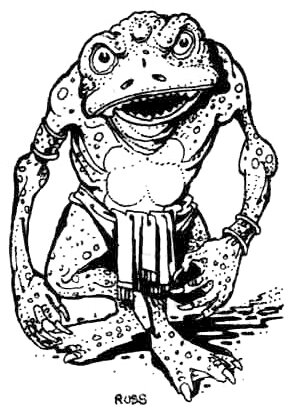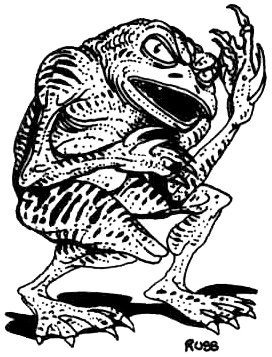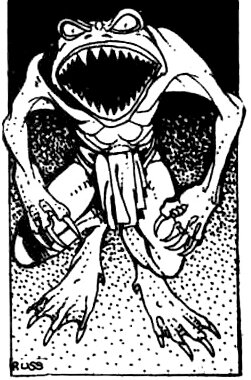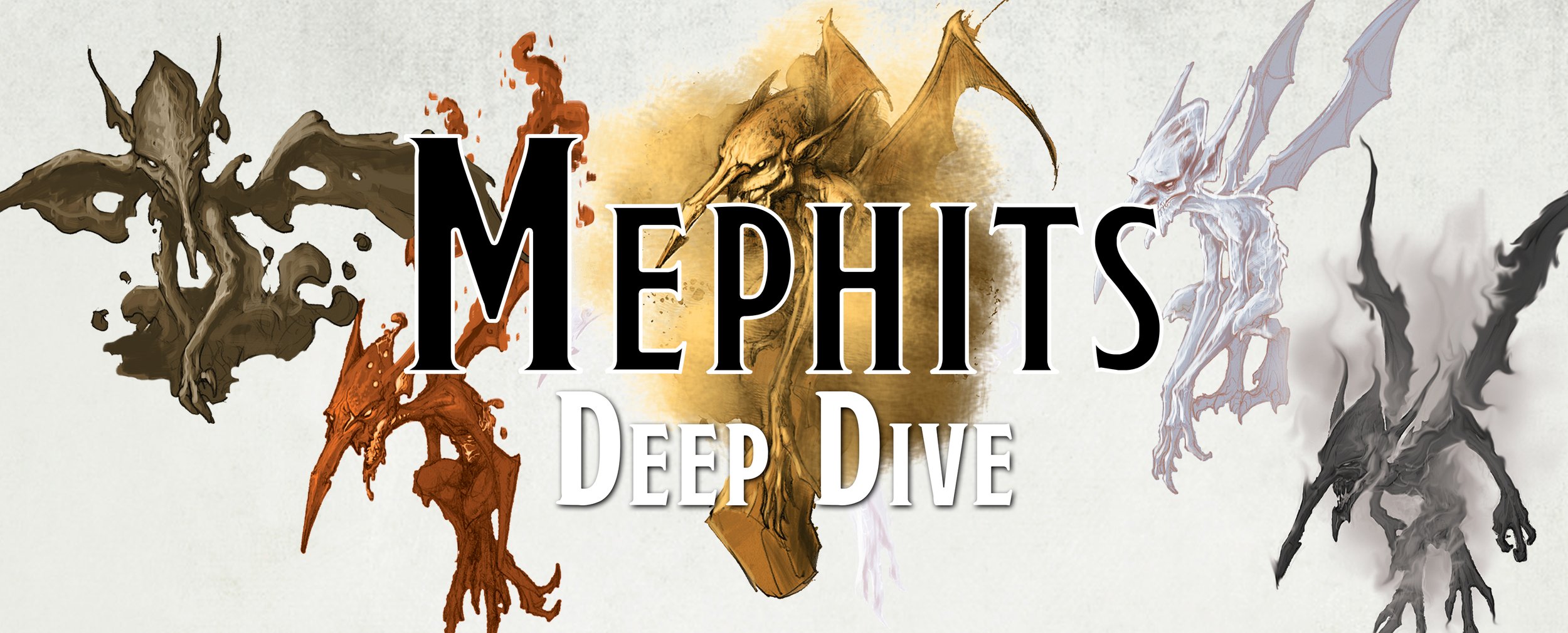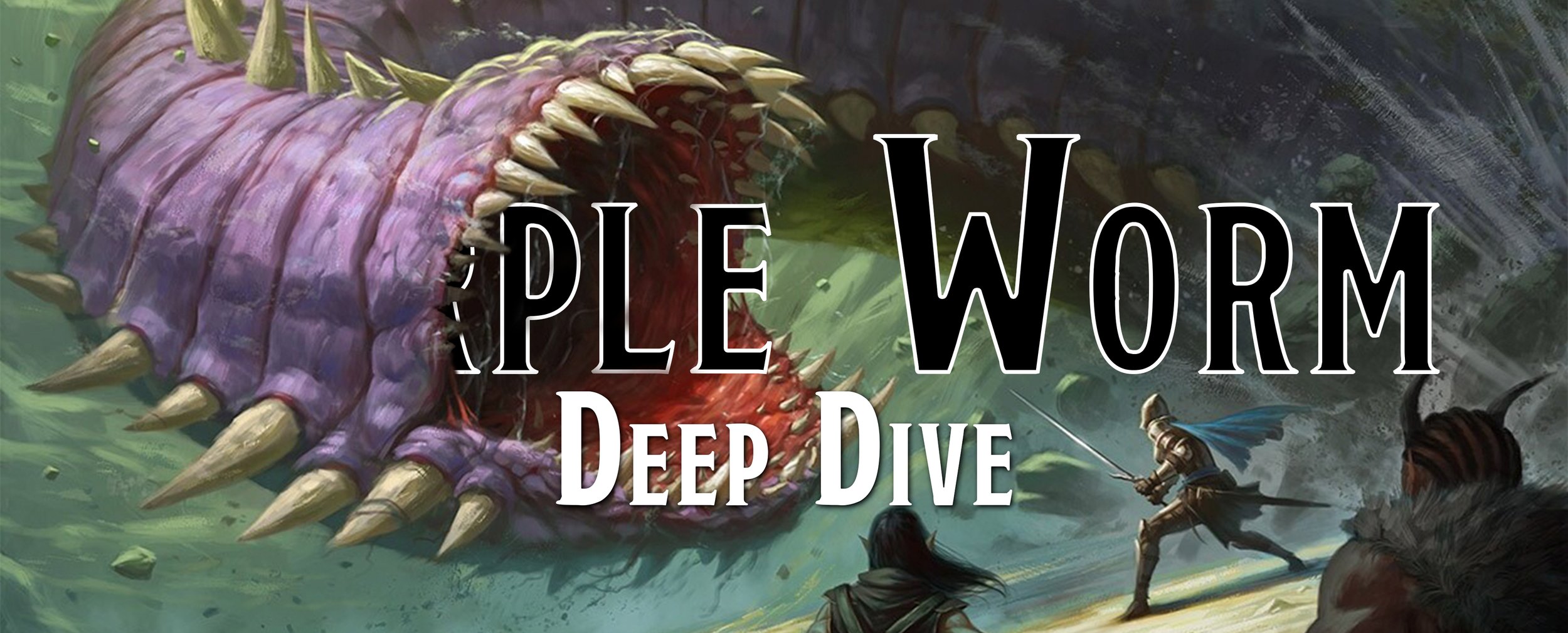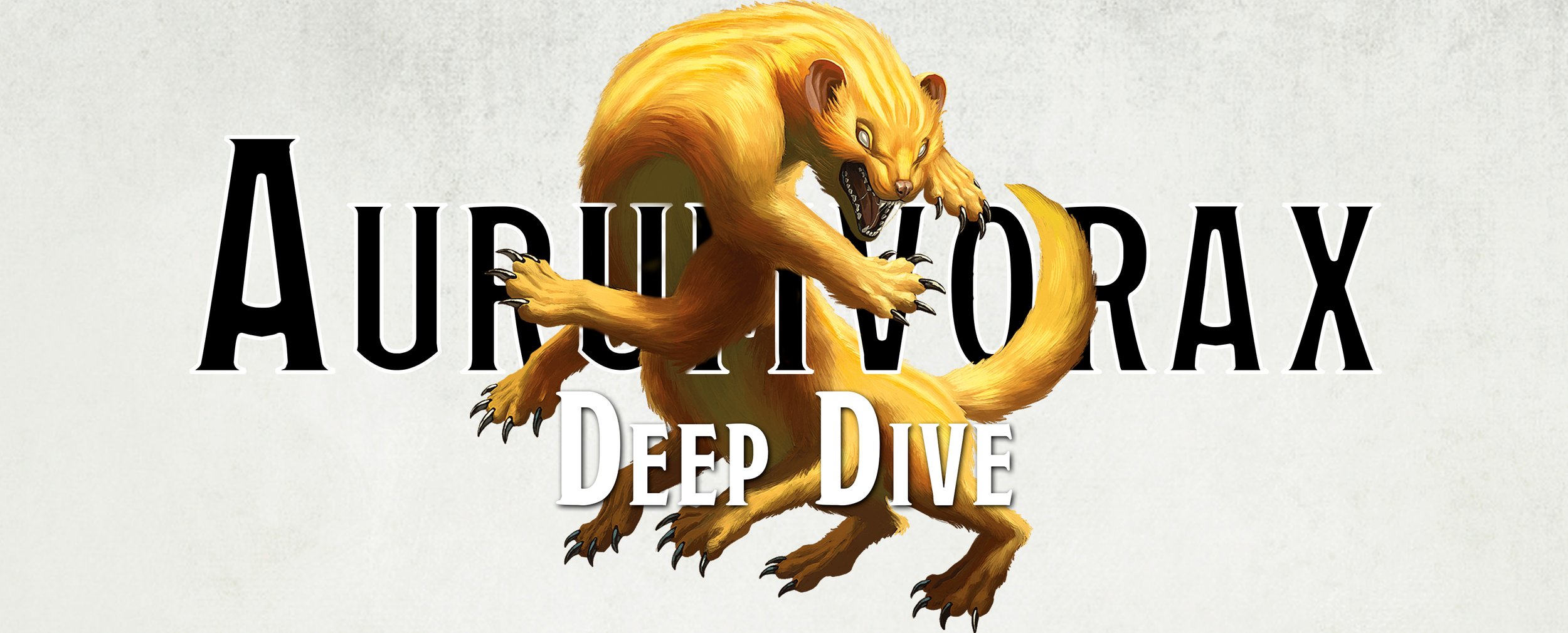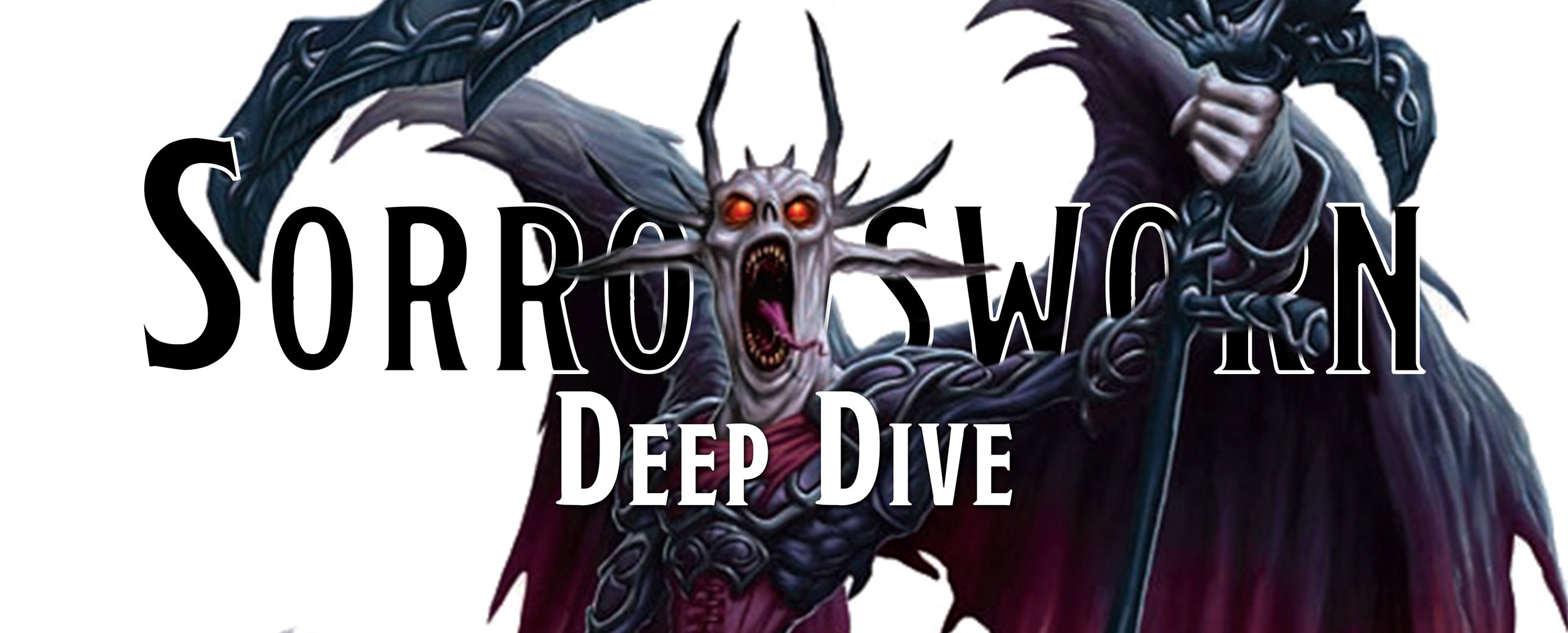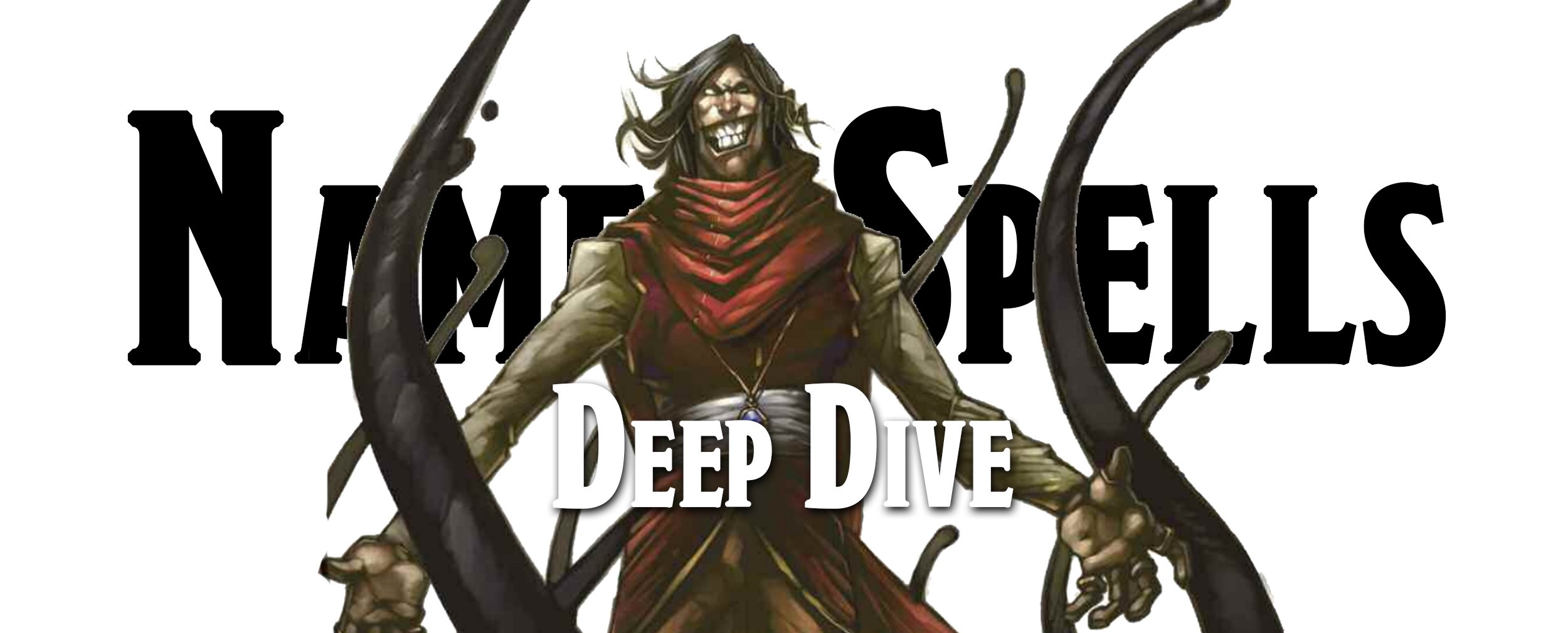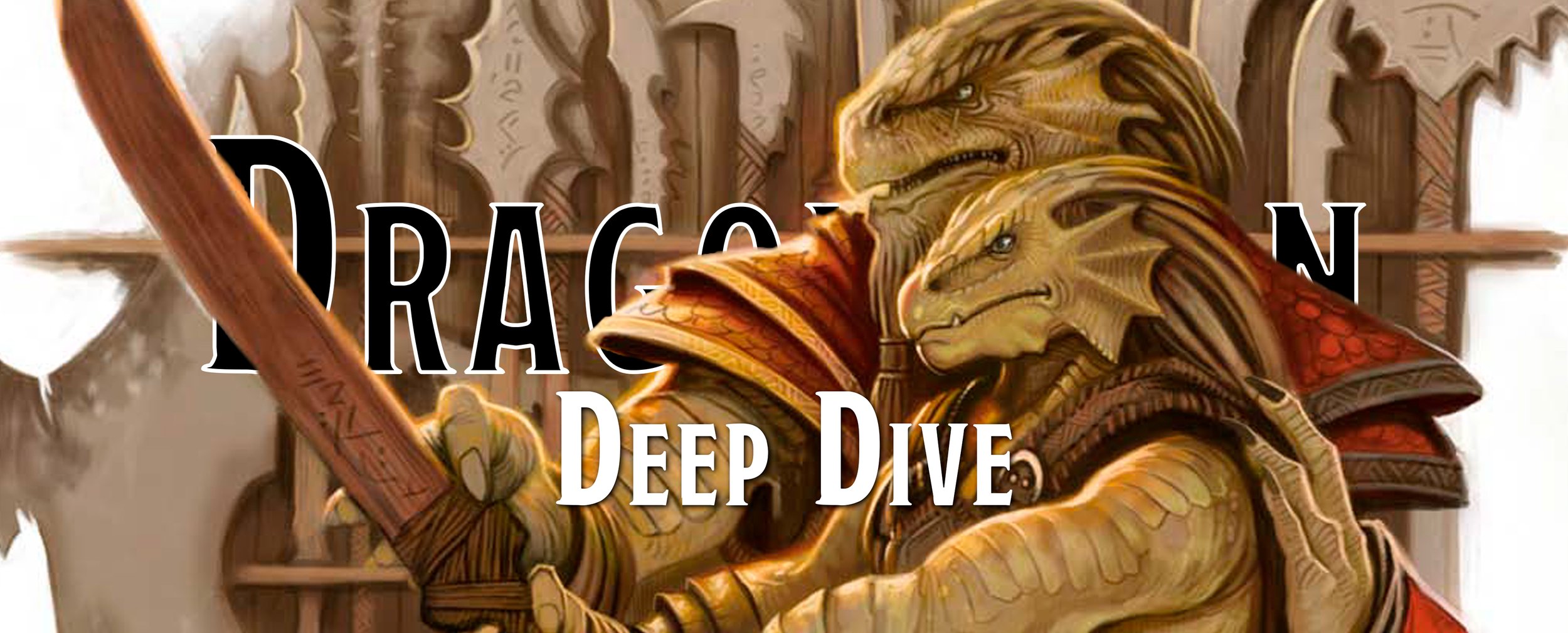Deep Dive - The Slaadi
The Slaadi were created by Charles Stross, who seems to have a thing for horrific frogs. Giant, horrible frogs. Charles Stross is a British writer who wrote several articles for White Dwarf magazine and several of his creatures have made their appearance in the very first Fiend Folio released in 1981. As the creator of the death knight and the gith, all creatures that still give us nightmares to this day, he had this to say about the Slaadi.
… the fact that I was running a fever when I came up with the Slaadi is probably not going to surprise anyone — think of ‘em as my independent exploration of Lovecraftiana. (I didn’t discover H. P. Lovecraft until a couple of years later.)
Charles Stross Interview, SevenDead.com
With that in mind, we dive into the mind-breaking chaos-frogs.
AD&D - Slaad (Red)
Frequency: Rare
No. Appearing: 3-18
Armor Class: 6
Move: 6” (can hop at 9” rate for maximum of one turn in one hour)
Hit Dice: 7
% in Lair: 30%
Treasure Type: F
No. of Attacks: 3
Damage/Attack: 1-4/1-4/2-16
Special Attacks: See below
Special Defenses: Regeneration - See below
Magic Resistance: 35%
Intelligence: Low
Alignment: Chaotic Neutral
Size: L (8’ high)
Psionic Ability: Nil
Level/X.P. Value: VI/875 + 8 per hit point
Fiend Folio, 1981 TSR Inc. / Red Slaad
The Slaad is first introduced in the Fiend Folio (1981) and there are quite a lot to meet. There are five different colored Slaadi, along with two Slaadi Lords presented in the book, and none of them are described as friendly. In order of most likely to be killed by to least likely to be killed by, it begins with the Red Slaad, Blue Slaad, Green Slaad, Gray Slaad, and, lastly, the Death Slaad. Pink, purple, orange, and yellow are probably sad because they didn’t get a Slaad, but let’s be honest - a pink Slaad wouldn’t be very intimidating.
The two Slaadi lords have their own things going on and we’ll jump over to them once we get past the basics of these creatures.
Fiend Folio, 1981 TSR Inc. / Blue Slaad
The Slaadi are large frogs with the tallest of them coming in at 10 feet tall and the shortest ones around 6 feet tall. While you might think that these bipedal frog-monsters would get taller as they get more powerful, that isn’t the case. In fact, the strongest among them, the Death Slaad, are only 6 feet tall. Of course, you might want to skip calling them shorties as all Slaadi have powerful claws on long arms, massive heads with sharp teeth, and eyes filled with hatred for probably everything. They speak their own language, turning their nose up at your basic common tongue, but will still communicate with telepathy and can talk to any intelligent creature in this way. Of course, they probably are just wondering, telepathically, the best way to cook you after they kill you.
Luckily for you, these giant frogs aren’t typically found on the Material Plane as they reside, and originated, from the Outer Plane of Limbo. For those who aren’t familiar with this lovely place, it is a chaotic plane of existence where the githzerai make their home to train themselves against the raw currents of chaos. Though, don’t breathe a sigh of relief just yet as they can still be found wandering about the material worlds. Now, they aren’t here on a vacation, but rather because they were forced to by a summoner or one of the Slaadi Lords to bring misery and woe to the world. They are naturally chaotic creatures and hate anything that one could describe as orderly or lawful.
Fiend Folio, 1981 TSR Inc. / Green Slaad
With all the different colored Slaadi in existence, it should come as no surprise that they live within a fairly strict hierarchical system. The Red Slaad are at the bottom and the Slaadi Lords sit atop this hellish mountain of murderous and cruel frogs. Luckily, all Slaadi have names, which is great since it’s better than telling Red 2 to cut the chatter and you can just call them by their name. Of course, if you do know their name, you can summon them which is not something we recommend. Mostly because, if you do, they’ll probably not listen, eat you, and then return to Limbo.
Maybe you’ve followed the detailed guidelines we outlined above, you know, don’t summon them, but still find yourself facing off against them. Should you fight? Should you run? Should you just pledge your mortal soul to their cause? Well, depending on what color they are, they are going to have different abilities and it may change what you decide on.
Fiend Folio, 1981 TSR Inc. / Gray Slaad
The most common of all Slaadi are also the weakest, isn’t it nice how that works out for you? They are typically in search of slaves to bring back to Limbo and, if you try to fight them, several things can happen. Firstly, they regenerate 3 hit points every round so good luck with that. Secondly, if they hit you with their claws, they’ll insert a small pellet under your skin and you get to make a saving throw against poison. If you fail, you die within 3 to 36 hours unless someone can cast several different spells like barkskin or cure disease. They can also cast power word: stun and summon a few Red Slaadi once per day, so you’re taking a risk that any fight won’t simply swing wildly out of your favor in quick order. But maybe that’s the worst that the Slaadi have to offer, you know, get the worst over first.
Blue and Green Slaadi are much stronger than the Red Slaadi and are ferocious fighters, like the Blue getting four attacks every round instead of just the two thanks to having scythe blades on their wrist. Then again, the Green is only harmed by magical weapons and can cast a ton of magic from telekinesis to delayed blast fireball and even can regenerate lost hit points at the same rate as the Red. Even if you can kill a Green Slaad, they reincarnate after 24 hours as only a Blue Slaad so we recommend at this point just trying to outrun the rest of your party so at least you survive.
Fiend Folio, 1981 TSR Inc. / Death Slaad
After that are the Gray Slaadi who are incredibly powerful and are thought of as executioners sent by the Slaadi Lords to the Material Plane. They are often disguised as humans, which isn’t great if you are trying to decide if the guy in front of you with a massive +2 magical sword, like a sword of sharpness, is about to cut you in half with a single swipe. They also can cast a variety of spells like flame strike, shape change, and our favorite, ball of lightning which deals 8d6+6 lightning damage - so good luck on fighting them.
The last regular Slaadi are the Death Slaadi and you are probably not going to encounter them since there are only four of these known in existence. They also carry a powerful magical sword, with a sword of sharpness being fairly weak for them, but they’ll only use that if they are in human form. If they are in frog form, they’ll use their powerful claws and then bite you, which ends up draining you of up to 3 levels if you fail a saving throw against it. In addition, as you might have guessed, they also get some powerful spells like all the ones the lower Slaadi get as well as astral projection and cloudkill. They even have a 90% chance of successfully summoning more Slaadi to help them kill you, which is way higher than their common, lesser brethren.
Fiend Folio, 1981 TSR Inc. / Ygorl
Of course, it can only get worse from there as there are two Slaad Lords detailed in this book. The first is a cutie known as Ygorl the Lord of Entropy who appears as a skeletal shadow with black bat-wings, stands 12 feet tall, and wields an oversized sickle. The sickle is made of pure adamantine, has a +5 bonus to hit, and if you are struck by it, you’ll have to make a save or just immediately die. Ygorl also gets magic up to a 13th-level cleric and prowls around the Material Plane just because he wants to. If you do happen to see death itself coming at you, you’ll also have to deal with his pet he rides on, an ancient brass dragon called Shkiv.
If you’re liking your chances against all of these previous Slaadi, including Ygorl, you may have a death wish and we suggest you check out our last Slaad Lord, Ssendam the Lord of the Insane. He is a shiny gold frog in his natural state, though when he visits the Material Plane he appears as either a human or a giant amoeba-thing with tentacles. In human form, he wields a powerful sword known as the Black Sword which, if it hits you, automatically casts power word: stun. As an amoeba, Ssendam attacks with his giant pseudopods that deal a bit of damage but drains up to 4 levels of experience out of you. Ssendam even has almost all the other abilities of the lesser Slaadi and can’t be hit by anything short of a +3 weapon. Luckily, Ssendam is a friendly sort and freely gives out his name, probably hoping someone will try to summon him. Of course, it goes on to state no one would ever summon him as we can only assume it would end in tragedy for them, their family, and their whole city.
Fiend Folio, 1981 TSR Inc. / Ssendam
If you have trouble seeing the color of a Slaadi, maybe you’re color blind or it's real dark, you are in luck as they also have another means of telling them apart. Each Slaadi has a jewel trapped within their skull which acts as a way of demonstrating their rank within the Slaadi as a whole and within their color. These jewels are incredibly important to a Slaadi as it literally holds their life force and if they are removed, typically by some powerful spells, then you can draw them out and control the Slaadi. A controlled Slaad will do three tasks for you and then they get their jewel back, if you try to string them along or twist your commands around to get them to work for all eternity, well, you’ll find yourself being dragged to Limbo to become their slave as they will do everything they can to destroy you, even if it means you destroy them by destroying their jewel.
Even if the three tasks are really easy, like making you a sandwich, the Slaad isn’t going to be happy about any of it. You can appease the Slaad, often by offering lots of slaves to them to take back to Limbo in your place, or you are just going to have to fight it to the death and hope it doesn’t have any siblings it summons to kill you.
The Slaad is detailed further in the Manual of the Planes (1987) and we get a full description of Limbo. The Slaadi share the first layer of Limbo with the gith, with the Slaadi being the native creatures of this plane. The two races maintain peaceful relations with one another, which is no small feat given the gith’s tendency to keep to themselves and the Slaadi being, well, the Slaadi. These frog-monsters are immune to the chaos and elemental fury found on Limbo and seek to bring its chaos and fury upon any place that is a bit too lawful or orderly for them, which is pretty much everywhere. Beware of vacationing Slaadi as they are rarely just wandering the planes to relax.
2e - Slaad (Blue)
Climate/Terrain: Limbo
Frequency: Rare
Organization: Group
Activity Cycle: Any
Diet: Carnivore
Intelligence: Low (5-7)
Treasure: K, Q
Alignment: Chaotic neutral
No. Appearing: 2-12
Armor Class: 2
Movement: 6
Hit Dice: 8+4
THAC0: 13
No. of Attacks: 5
Damage/Attack: 2-12/2-12/2-12/2-12/2-16
Special Attacks: Disease
Special Defenses: +1 or better weapons to hit
Magic Resistance: 40%
Size: L (10’ tall)
Morale: Steady (11-12)
XP Value: 16,500
Monstrous Compendium Outer Planes Appendix, 1991 TSR Inc.
The colorful Slaadi appear at first in the Monstrous Compendium Outer Planes Appendix (1991) and only the Blue and Red Slaadi are reprinted in the Monstrous Manual (1993). Not many changes are present for the Slaadi, though the mention of any Slaad Lords are removed with the Death Slaadi rising to take their place as the ultimate masters of their race. The bottom of this hierarchy are the poor Red, Blue, and Green Slaadi who get bossed around solely because they aren’t strong enough to ignore the orders given to them by the Gray and Death Slaadi.
The singular new piece of information for the Red Slaadi is the pellet that they leave behind on their attacks, and it is a Slaad egg. When a Red Slaad successfully hits you with its claws, it can impart an egg-pellet under the skin, completely unknown to the victim who probably has their hands full with a rather dangerous frog-monster having their undivided attention. The egg-pellet then travels through the body towards the heart and after three months, the egg-pellet forms into a baby Red Slaad who then eats their way out of the host, killing them instantly. The only way you might have the faintest idea something is wrong is that 24 hours before the birth, the host falls horribly ill. To save the host, you must cast remove curse or watch as they become an unwilling parent to a Red Slaad.
Monstrous Manual, 1993 TSR Inc.
The Slaadi reappear in the Planescape Monstrous Compendium Appendix I (1994) with even more details on their ecology. They can often be found around the Blood War, the eons-long war between devil and demon, though they don’t pick sides. Instead, they wander the battlefield, munching on the corpses and finding wounded creatures to become unwilling hosts for the continuation of their species. These wounded creatures are then pulled back to Slaadi camps where they are left to rot in horrible conditions while they slowly gestate the Slaadi viruses and eggs they have been implanted with. This process is one of the few reasons why the lowest ranks of the Slaadi are even able to stand each other as there is an intense rivalry between the Red and Blue Slaadi. It’s revealed that when a Red Slaadi injects an egg-pellet, it will grow up to be Blue Slaadi, while a Blue Slaadi delivers an egg into their victims and, after 3 months, the creature will be transformed into a Red Slaadi. This is a source of internal frustration for these Slaad.
Planescape Monstrous Compendium Appendix 1, 1994 TSR Inc.
The Green Slaadi are also created in a similar process but requires a Red or Blue Slaadi to impregnate a powerful individual. The baby Slaad will turn into a Green Slaad and the Blue and Red Slaadi will do everything they can to keep the Green alive and happy. This brings us to how the Gray and Death Slaadi are formed. The Gray Slaad are formed when a very powerful Green Slaad decides to go off on a year-long retreat, returning as a Gray Slaad with no information on how this process happens. The Gray Slaad can then turn into a Death Slaad, though very few can accomplish such a feat. It requires immense power and ancient Gray Slaad to perform foul and evil rituals, transforming and twisting themselves into death itself.
Every Slaad wants to bring their chaotic sense of order to the universe but dealing with troops, military strategy, and political intrigue all just seems too tiring, especially when it comes to dealing with Slaadi troops. This is just fine with the boss Slaadi, as they can use the lower Slaadi for their dirty work and not have to worry about them needing time off to go fight in some silly war. If they do want a private army, they’ll end up just finding some weak demons, devils, or other weaker creatures to boss around.
Planescape Monstrous Compendium Appendix 1, 1994 TSR Inc.
In the Planes of Chaos (1994) we delve into the Slaad society and psychology. The Slaadi are described as nomads, who have nothing but contempt and dislike for all others. Their life revolves around the chaos of Limbo, embracing the anarchy that comes along with such a lifestyle. The largest coalition of Slaadi can be found near a massive black crystal known as the Spawning Stone. This is the only place where the Slaadi can fertilize their internal egg sacs, though they are hermaphroditic and so don’t require the help of anyone else. There is a single Death Slaad that watches over the Spawning Stone, known as the Guard of the Stone. It is thought to be the most powerful Slaad and has complete control over thousands of miles of Limbo around the stone.
Dragon #221, Sept. 1995 TSR Inc. / Ssendam
Dragon #221 (Sept. 1995) brings us the article Lords of Chaos, which returns Ssendam and Ygorl, as well as two now Slaad Lords. These four beings came into existence via the ascension of a select few Death Slaad, though dozens or even hundreds have attempted to reach such deific-like status. These introspective frogs were driven by something inside them to deepen their knowledge of chaos, and in doing so, rose to the level of a Slaad Lord. Each is unique, bringing their special brand and interpretation of chaos to Slaad society.
Dragon #221, Sept. 1995 TSR Inc. / Ygorl
Ssendam cares very little in the day-to-day life of your average Slaad, preferring to use her mental prowess to reach out to the Material Plane, worm her way into your brain, and drive you mad. Her overarching goal is to plunge the entire multiverse into madness, so if anarchy is your thing, you could become one of her followers. Ygorl on the other hand seeks to bring his brand of order to the chaos, a focal point from which everything flows. To this end, Ygorl created the Spawning Stone to become a focal point for all Slaadi and to help grow their numbers to massive proportions. Like Ssendam, Ygorl has no followers, but all Slaadi follow his commands, lest they be devoured by the Slaad lord.
Dragon #221, Sept. 1995 TSR Inc. / Chourst
The first of the two new Slaad lords, Chourst, is called the Lord of Randomness, as he claims to embrace the true nature of Limbo. His only goal in life is to enjoy the destructive and erratic nature of Limbo, slaughtering gith one moment and enjoying a cup of tea the next. He revels in the destruction of Limbo’s terrain, and like a hurricane, will forever alter the landscape of a place he decides to visit. The next Slaad Lord is Rennbuu the Lord of Colors, and while he is the most fashionable of all the Slaad Lords, he is also the most vicious and. His skin shines with bright hues and a long and untamed mane of stark white hair sits atop his head. Rennbuu considers himself an artist, traveling the planes and changing the colors of unfortunate individuals he may encounter. Whether he denotes a Gray Slaad to Red, he also uses his power to create purple goblins, albino drow, and other works inspired by his love of colors.
Dragon #221, Sept. 1995 TSR Inc. / Rennbuu
The Slaadi also appear in Hellbound: The Blood War (1996), in Faces of Evil (1997), and the young versions of the Red Slaad appear in Dungeon #77 (Nov. 1999). These sources detail their love of chaos and their inability to truly become a cohesive group. They even try, on occasion, to take sides in the Blood War, but devils and demons alike know not to trust them and, once they are done using the Slaadi, will destroy any survivors in their bloody conflict.
3e/3.5e - Slaad (Green)
Large Outsider (Chaotic, Extraplanar)
Hit Dice: 9d8+36 (76 hp)
Initiative: +5
Speed: 30 ft. (6 squares)
Armor Class:23 (–1 size, +1 Dex, +13 natural), touch 10, flat-footed 22
Base Attack/Grapple: +9/+19
Attack: Claw +14 melee (1d6+6)
Full Attack: 2 claws +14 melee (1d6+6) and bite +12 melee (2d8+3)
Space/Reach: 10 ft./10 ft.
Special Attacks: Spell-like abilities, summon slaad
Special Qualities: Change shape, darkvision 60 ft., fast healing, immunity to sonic, resistance to acid 5, cold 5, electricity 5,and fire 5
Saves: Fort +10, Ref +7, Will +6
Abilities: Str 23, Dex 13, Con 19, Int 10, Wis 10, Cha 12
Skills: Climb +18, Concentration +10, Hide +9, Jump +18, Listen +12, Move Silently +13, Search +12, Spot +12,Survival +6 (+8 following tracks)
Feats: Cleave, Improved Initiative, Multiattack, Power Attack
Climate/Terrain: Ever-Changing Chaos of Limbo
Organization: Solitary or gang (2-5)
Challenge Rating: 9
Treasure: Standard
Alignment: Always chaoticneutral
Advancement: 10–15 HD (Large); 16–27 HD (Huge)
Level Adjustment: +7
Monster Manual, 2003 WotC / Blue & Death Slaad
The Slaadi, which include the Red, Blue, Green, Gray, and Death varieties, appear in the Monster Manual (2000/2003) with some power behind their frog-like bodies. Don’t let their frog-like appearance fool you though because even the weakest among them are enough to challenge level 7 characters. Few things change for these chaotic toads with the most interesting all happening to the lowly Red Slaadi.
Red Slaadi lose all of their previous spellcasting abilities but now get a special ability where they can pounce on top of you and tear you apart with their bite and two claws that have the chance of implanting a Blue Slaad egg. Luckily for you, if you are implanted, you only have it for a week instead of months - which thinking about it, maybe that isn’t so good as you still immediately die if it is born inside of you. After that, the Red Slaadi get to embrace their frog side and can emit a stunning croak that erupts around them, stunning anyone unable to resist its thunderous noise. In addition to these changes, all Slaadi get access to a variant chart, which allows the DM the opportunity to create a unique Slaad. By rolling on a chart, the unique Slaad you are fighting might have a breath weapon, vestigial wings, an extra arm to gore you with, or get a larger head for their big brain, granting them a boost to their intelligence.
Monster Manual, 2003 WotC / Gray, Green, & Red Slaad
Epic Level Handbook, 2001 WotC
Two more Slaadi are introduced in the Epic Level Handbook (2001) with the White and Black Slaadi. These entities make a Death Slaad seem like a cute teddy bear and are as powerful as some of the most ancient of dragons. A White Slaad is as white as snow and gleams with an inner light, though don’t let its pure-like color fool you. It is an entity of pure chaos, only forming after a Death Slaad has spent a decade within Limbo and gone on a year-long retreat to better themselves. Their very touch is enough to cause chaos to twist and batter at their enemies, their acidic-like spittle causing persistent chaotic damage to those who would challenge them. If Death Slaadi are scary, these creatures are horrifying as they can cast even stronger spells like finger of death, implosion, and power word kill.
Epic Level Handbook, 2001 WotC
If a White Slaad can survive another 10 years in Limbo, and we can’t imagine there are too many threats for such a powerful creature, they can go back on vacation for a year where they then become a Black Slaad. These creatures are pure darkness and appear like a frog-monster-shadow with skin so black that all details are lost except for their two glowing white eyes. They are like the White Slaad but with a larger list of spells that they can cast at will, like power word kill, and can channel the forces of chaos to devastating effects by their very touch. The biggest difference is that they always fight within the confines of a deeper darkness spell as they can see through even the most powerful of magical darkness, allowing them to be pure destructive monsters that lurk unseen in the pitch blackness.
Manual of the Planes, 2001 WotC
The Manual of the Planes (2001) returns in this edition for a great deal of information on Limbo as well as the Slaad. They are still enraptured by the Spawning Stone, the only way for them to produce more of their kind that doesn’t involve ejecting their eggs into unwilling hosts. The Guardian of Stone still watches over the stone, ensuring that no outsider ever gets the chance to gaze or touch their special stone. There is some information about the great Slaad Lords, that they are a jealous bunch who hated the idea of a Slaad with a weird genetic mutation suddenly forming thanks to the chaotic energies of the Spawning Stone. To protect their own rule over the Slaad, they carved ancient runes into the Spawning Stone, limiting the chaotic mutations it could create, which is why there are only a handful of different Slaadi out there. To us, it seems like these Slaad Lords are going against the chaotic nature of Limbo, imposing a strict order on their species and we for one can’t wait to see them toppled from their thrones and brand new Slaad to form and rise up! Wait, that’s probably a bad thing, isn’t it?
Fiend Folio, 2003 WotC
In April of 2003, the Fiend Folio and Dragon #306 created two new Slaadi that were formed by the Spawning Stone in strange ways. Fiend Folio presents the Mud Slaad, finally allowing the Red Slaad to no longer be at the bottom of the Slaad hierarchy. They are small, brown, and unremarkable and the best thing we can say about them is that they can cringe. This allows them to cower in fear so intensely that you can’t bring yourself to attack the pathetic creature. Dragon #306 brings with it the Gormeel, which are Slaadi that hate other Slaadi. In the pure chaos of Limbo, over eons of creating and destroying, lawful creatures are bound to be created by its energies and these individuals are formed thanks to the runes on the Spawning Stone and the Slaad Lords have been unable to fully eliminate them from spawning. They have allied themselves with the githzerai and do everything they can to help them destroy other Slaadi.
Dungeon #101, August 2003 WotC
A new Slaad Lord is introduced in Dungeon #101 (Aug. 2003), and this entity has two heads and is known as Bazim-Gorag, the Firebringer. The Firebringer has been imprisoned by an arch magus for untold decades until recently when the tower fell. While Bazim-Gorag is still trapped, he is much closer to being freed and needs five conditions to be fulfilled to finish the unbinding ritual and allow him to spread his treachery. Of course, if you want to kill him, it won’t be a walk in the park as his abilities and powers include such things as surrounding himself in a shroud of fire and shooting explosive energies that will destroy all but the most powerful of adventurers.
Let’s say after all this, you want to play as a Slaad, well the closest way that that is going to happen is if you take a Slaadi Bloodline as presented in Unearthed Arcana (2004). These bloodlines are a variant rule wherein a character can take levels in a specific bloodline, like Slaadi, allowing them to gain similar abilities to such powerful creatures as they level up. If you go with this bloodline, you can get bonuses for jumping, your Strength score, interacting with Slaadi, and even get the ability to resist damage like an actual Slaadi.
4e - Slaad (Gray Slaad/Rift Slaad)
Level 13 Skirmisher
Medium elemental humanoid / XP 800
Initiative +12 / Senses Perception +7; low-light vision
HP 128; Bloodied 64; see also planar flux
AC 27; Fortitude 25, Reflex 26, Will 24
Immune chaos phage
Speed 6, teleport 4
Claws (standard; at-will) ✦ Disease +18 vs. AC; 2d8 + 2 damage, and the slaad makes a secondary attack against the same target. Secondary Attack: +16 vs. Fortitude; on a hit, the target contracts chaos phage.
Condition Transfer (immediate interrupt, when hit by an attack that applies any conditions; recharge 5-6 ) Ranged 5; +16 vs. Fortitude; conditions applied by the triggering attack affect the target instead of the slaad.
Induce Planar Instability (standard; encounter) Close burst 3; +16 vs. Will; 1d8 + 2 damage, and the target shifts 3 squares and is knocked prone.
Planar Flux (free, when first bloodied; encounter) ✦ Teleportation The slaad teleports 8 squares and becomes insubstantial until the end of its next turn.
Alignment Chaotic Evil / Languages Primordial
Skills Athletics +13, Stealth +15
Str 15 (+8) Dex 18 (+10) Wis 12 (+7) Con 16 (+9) Int 9 (+5) Cha 14 (+8)
Monster Manual, 2008 WotC
The Slaads, the new plural form of Slaad, appear in the Monster Manual (2008) and there is a sudden flip in their hierarchy. They are still described as frog-like creatures who are borderline insane but are now elementals as opposed to aberrations, outsiders, or anything else they might have been before. They are much less intelligent than the previous editions, becoming almost mindless creatures, sowing disorder, causing mayhem, and wreaking havoc wherever they go. The typical Red, Blue, Green, and Gray Slaad are present as well as the Slaad Tadpole and the Black Slaad.
Monster Manual 2, 2009 WotC / Flux Slaad
As we mentioned before, the hierarchy of the Slaads has been uprooted. Now, the Gray Slaad is the weakest of the mature Slaads with Red, Blue, and then Green stronger and above them. At least the Gray Slaad gets a cool nickname and is known as the Rift Slaad, though every Slaad gets a nickname so it is little comfort in these trying times. The Red Slaad is known as the Blood Slaad, Blue as the Talon Slaad, Green as the Curse Slaad, and the greatest of the Slaad, the Black, is called the Void Slaad. The Black Slaad acts as the big bad boss, bullying and summoning the other Slaad as they see fit, and it seems as if the old Death Slaad has left us.
Monster Manual 3, 2010 WotC / Golden Slaad
Each of these frog-monsters, except for the Black, can inflict a horrendous disease upon those that they strike known as chaos phage. This powerful disease affects your mental abilities, causing you to turn into a creature who attacks their allies in a fit of madness. As you progress in the disease, eventually it erupts from your skull, killing you instantly and forming the Slaad Tadpole, a curious creature who can phase in and out of substantially, making it very difficult to kill the creature.
Monster Manual 2, 2009 WotC / Slaad Spawn
The next two Monster Manuals bring even more Slaad madness to the multiverse. In Monster Manual 2 (2009), we are introduced to the Flux Slaad and the Slaad Spawn, while in Monster Manual 3 (2010) we get the Golden Slaad and the Putrid Slaad. The Flux Slaad is a weaker Slaad completely overtaken by chaos itself so much so that it has vulnerabilities and resistances to elemental damage at random. When a Slaad is fought, the DM rolls to see what element; of cold, fire, lightning, necrotic, psychic, or thunder, it is vulnerable to and all others it is resistant to. When it is struck by an attack it is vulnerable to, it then immediately shifts and changes so that it is vulnerable to a new element and is resistant to the one it was previously vulnerable for. As for the Slaad Spawn, these creatures are what happens thanks to the chaos and are mutated Slaad-eggs that grow inside of a suitably large Slaad, appearing like a boil. When it is time for them to be born, they explode out of the host Slaad and must devour huge amounts of food or become destroyed by the powerful energies within it.
Monster Manual 3, 2010 WotC / Putrid Slaad
The Golden Slaad is almost like an ooze and it morphs into one when reduced to half its health. While it fights, it teleports around a battle, biting and croaking with random effects it imparts on its enemies. It might deal extra damage, cause an enemy to teleport in a random direction, or even grant their opponent a free attack against a random nearby creature. They embody chaos itself and are only formed when a ‘normal’ Slaad is exposed, and absorbs, a chaos storm that erupts within the Elemental Chaos. Putrid Slaads, on the other hand, are purposefully created by necromancers who capture living Slaad and infuse them with shadow magic that ultimately ends up killing the Slaad and transforming them into an undead abomination. They are still suffused with chaos and elemental energies, but now are stronger than ever before with the ability to spew necrotic acid and become an almost unstoppable monster that follows only the commands of their creator or if a Black Slaad happens to come across them.
Manual of the Planes, 2008 WotC
With the reworking of the multiverse in 4th edition, the Slaads now reside in the Elemental Chaos as described in Manual of the Planes (2008). They are the embodiment of chaos, following along in the wake of chaos storms that they revel in. Occasionally they can be found fighting alongside demons, but more often than not this is only a chance encounter and, once the fighting is over, will then begin destroying each other until only the Slaad or the demons remain. Some think that Slaad were first formed in the Abyss, that they were once a race of demons who escaped that infernal place and now embrace the randomness of the Elemental Chaos.
The Plane Below: Secrets of the Elemental Chaos (2009) goes on to provide a large swath of information for the Slaad. The best way to describe the Slaads is that they know, above all else, that they are the only sentient creatures in all the multiverse and that all others are only imagining it. This type of thinking makes it very hard to negotiate with a Slaad, though on occasion you can successfully convince the Slaad you don’t exist, in which case it merely ignores your very existence and continues carving a chaotic path across the universe.
The Plane Below: Secrets of the Elemental Chaos, 2009 WotC
The Plane Below: Secrets of the Elemental Chaos, 2009 WotC
In addition to reaffirming the importance of the Spawning Stone and its hold on the Slaads, we are also introduced to the Chaos Phage Swarm, Green Slaad Madjack, Blue Slaad Digester, Gray Slaad Havoc, Red Slaad Juggernaut, White Slaad, and the Black Slaad Entropic. Each of these powerful Slaads have been changed and morphed by the elements, giving them new ways to torment and destroy you. The new Slaads, the Chaos Phage Swarm and the White Slaad, are just as chaotic as all other Slaads. The swarm attacks the closest living creature who isn’t a Slaad, churning around them in a great mass of tadpoles, spreading infection with every bite. The White Slaad, also known as the Chronos Slaad, can split itself into temporal replicas that allow it to see to the future, giving it an advantage in fighting its opponents as its replicas are destroyed and it gazes through time to find weak points.
The Plane Below: Secrets of the Elemental Chaos, 2009 WotC
Finally, Ygorl returns along with his mount, Shkiv, a dragon so corrupted by the chaos that it is impossible to know what dragon it once was. Ygorl, Lord of Entropy, is the best known of all the Slaad Lords and is a rather reclusive Slaad who rarely ventures forth, but when he does, it is to bring ultimate destruction with him. He still wields a scythe, but now instead of just killing you, it immobilizes you in place making it impossible to leave his aura of entropy that destroys and slowly dissolves anything close to him.
The last bit of information is provided in Player’s Option - Heroes of the Elemental Chaos (2012) and is what happens when you want a Slaad as your elemental companion. The Chaos Phage resides in your skull but doesn’t bother exploding out, a process that would kill you and form a Slaad Tadpole, instead it feeds on your mental energy and helps you bring down your opponents. It typically remains passive in your mind, but you can activate it when a nearby enemy falls below half their health, it then grants you a boost to your attacks against the enemy while you suffer some damage for its help.
5e - Slaad (Death)
Medium aberration (shapechanger), chaotic evil
Armor Class 18 (natural armor)
Hit Points 170 (20d8 + 80)
Speed 30 ft.
STR 20 (+5) DEX 15 (+2) CON 19 (+4 ) INT 15 (+2) WIS 10 (+0) CHA 16 (+3)
Skills Arcana +6, Perception +8
Senses blindsight 60 ft., darkvision 60 ft., passive Perception 18
Languages Slaad, telepathy 60 ft.
Challenge 10 (5,900 XP)
Shapechanger. The slaad can use its action to polymorph into a Small or Medium humanoid, or back into its true form. Its statistics, other than its size, are the same in each form. Any equipment it is wearing or carrying isn't transformed. It reverts to its true form if it dies.
Innate Spellcasting. The slaad's innate spellcasting ability is Charisma (spell save DC 15, +7 to hit with spell attacks). The slaad can innately cast the following spells, requiring no material components:
At will: detect magic, detect thoughts, invisibility (self only), mage hand, major image
2/day each: fear, fireball, fly, tongues
1/day each: cloudkill, plane shift
Magic Resistance. The slaad has advantage on saving throws against spells and other magical effects.
Magic Weapons. The slaad's weapon attacks are magical.
Regeneration. The slaad regains 10 hit points at the start of its turn if it has at least 1 hit point.
Multiattack. The slaad makes three attacks: one with its bite and two with its claws or greatsword.
Bite (Slaad Form Only). Melee Weapon Attack: +9 to hit, reach 5 ft., one target. Hit: 9 (1d8 + 5) piercing damage plus 7 (2d6) necrotic damage.
Claws (Slaad Form Only). Melee Weapon Attack: +9 to hit, reach 5 ft., one target. Hit: 10 (1d10 + 5) slashing damage plus 7 (2d6) necrotic damage.
Greatsword. Melee Weapon Attack: +9 to hit, reach 5 ft., one target. Hit: 12 (2d6 + 5) slashing damage plus 7 (2d6) necrotic damage.
Monster Manual, 2014 WotC
The Slaadi return in the Monster Manual (2014) and are now described as toad-like monsters, which is probably met with exultation from frogs everywhere who are tired of being associated with these horrific creatures. With the return of the Outer Planes, they have moved back to Limbo and the Gray Slaad is back near the top of their informal hierarchy. In fact, the soul gems they carry around in their skulls make a return and you can now use the gem as a controller for the Slaad but only those who have been formed by the Spawning Stone or have gotten close to it have one.
Monster Manual, 2014 WotC
The Spawning Stone is given an origin story in this edition and was created by Primus, the Supreme Modron who resides on Mechanus, who is as lawful as Limbo is chaotic. Primus had planned to transform Limbo into a place of order and so formed the stone from pure law before setting it adrift within the plane. This allowed lawful creatures, such as modrons and githzerai the ability to set up small bases within Limbo. Unfortunately, this has the disastrous side effect of creating the Slaadi who then ended up slaughtering every modron and githzerai that they could get their horrible claws into. While no one is quite sure if Primus meant for their creation, they are formed all the same and Primus seems to be largely ignoring these horrible toad-monsters.
Monster Manual, 2014 WotC
The presented Slaadi make up the main five; Red, Blue, Green, Gray, and Death, along with the Slaad Tadpole. These creatures harken back to the previous editions where Red creates Blue and Green Slaadi by ejecting eggs while the Blue infects creatures with a powerful disease that in turn creates Red and Green Slaadi. To be transformed into a Green Slaad in death, the victim must have been able to cast 3rd-level spells. As for Gray Slaadi, they are created at a random point in a Green’s life where they unlock a strange magical gift that transforms them. A Death Slaad, based on the information provided, is only created when a Gray eats the corpse of a Death Slaad, so that kind of makes it seem like the Death Slaads will get rarer and rarer as time goes on and less of their corpses are claimed by Gray Slaadi who can use them properly. Maybe there is another, hidden way to become a Death Slaad that isn’t mentioned within the text.
Monster Manual, 2014 WotC
Few other changes are present for the Slaadi and their only appearances in the rest of the edition are only as small encounters where they have little to do or work with. These adventures, Tomb of Annihilation (2017) and Waterdeep: Dungeon of the Mad Mage (2018), do little to show off the true might and fury of the Slaadi, and precious little information is revealed.
Monster Manual, 2014 WotC
The Slaadi have long been a creature of power and chaos, forming throughout the editions with few changes to speak of. They are monstrous frog-like creatures who have slowly grown more and more terrifying as the editions continue. These chaotic entities have been long-loved creatures of Dungeons & Dragons, though the recent edition has stopped them from gaining much infamy recently. Perhaps one day, we can all give thanks to Ygorl the Lord of Entropy when he comes swinging his deadly scythe to cast the world into chaos.
If you enjoy our Deep Dive series, consider
supporting us on Patreon and following us on Twitter!



